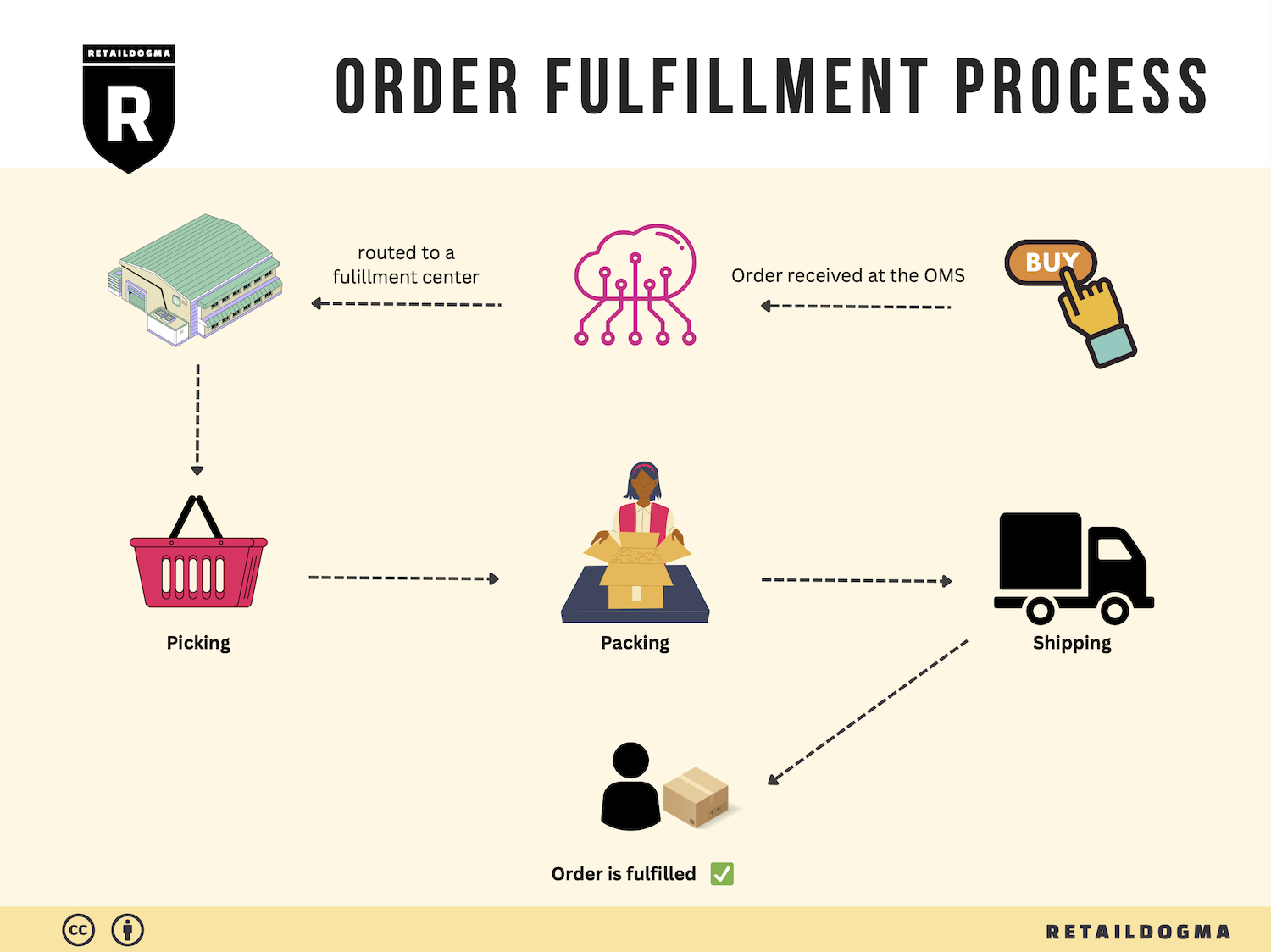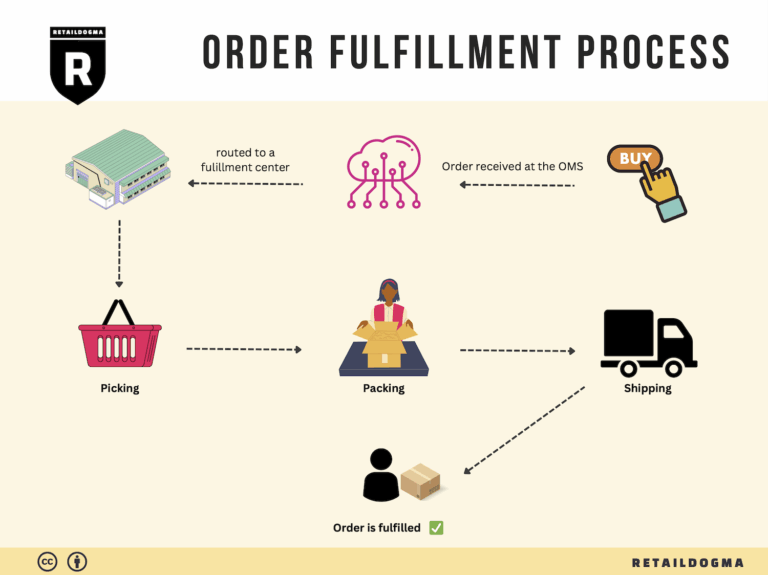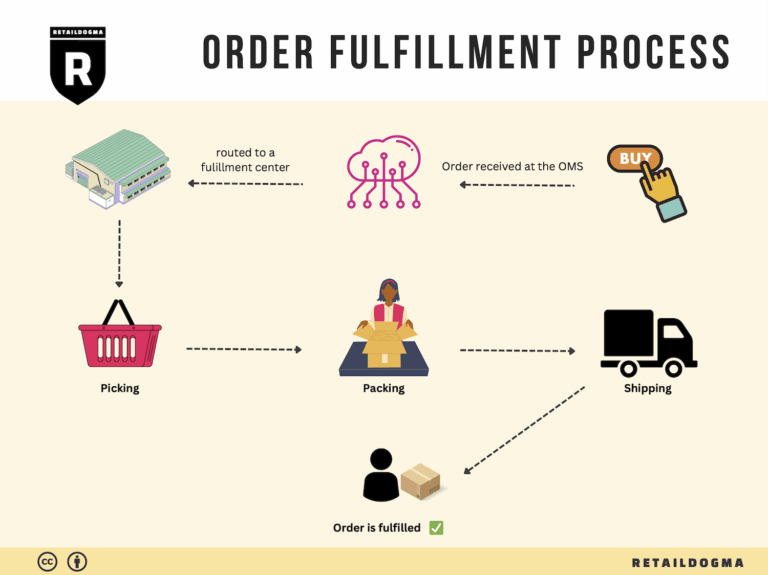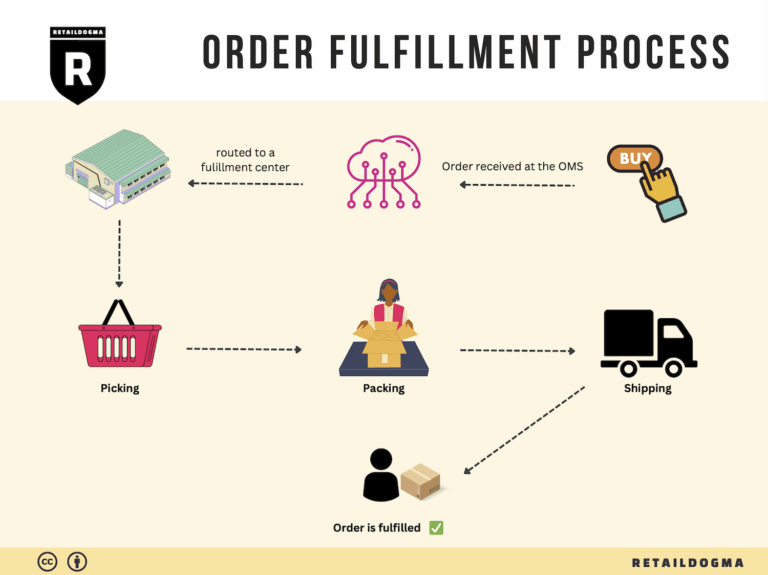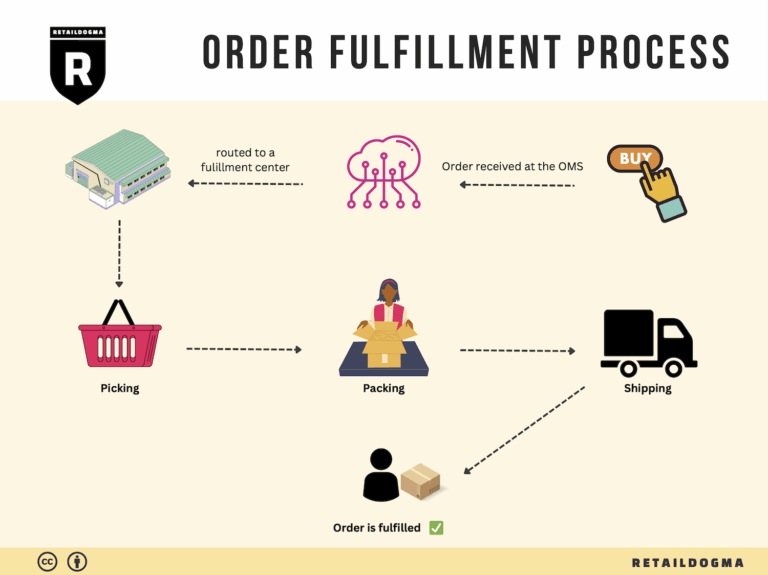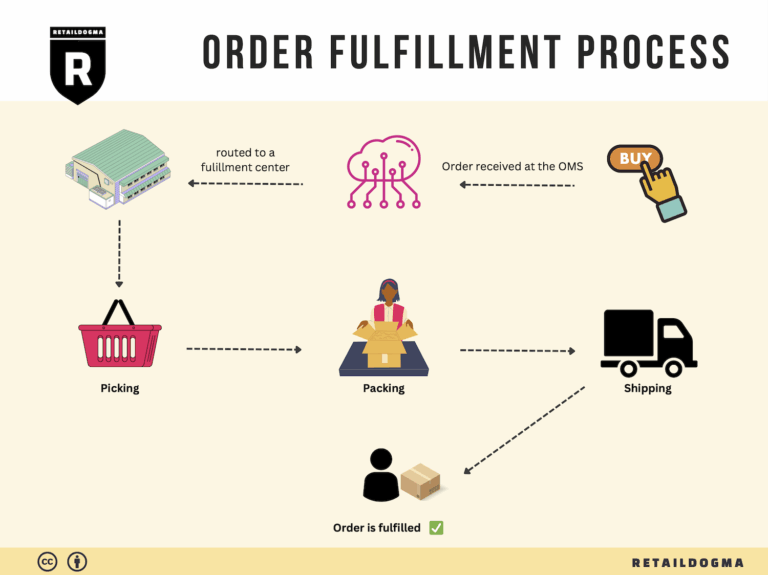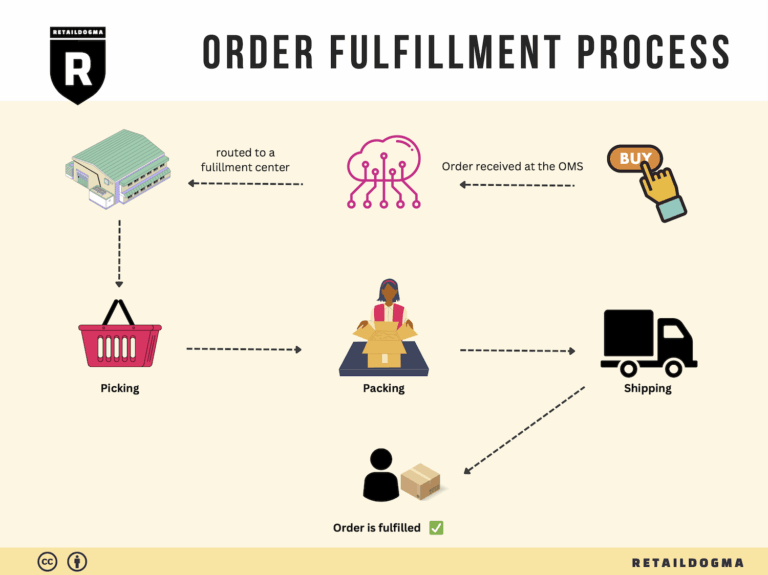How Order Fulfillment Works: A Step-by-Step Guide for Businesses
What is E-commerce Fulfillment? An Introduction for Growing Businesses
As your e-commerce business begins to grow, one of the most pressing challenges you may face is the overwhelming task of packing and shipping orders. The excitement of increased sales can quickly turn into stress as you juggle inventory management, order processing, and customer satisfaction. This is where e-commerce fulfillment comes into play. Simply put, fulfillment is the process of getting a product from your warehouse or storage facility to your customer’s doorstep, ensuring that their shopping experience is seamless and satisfying.
In this guide, we aim to demystify e-commerce fulfillment for growing businesses. We will explore various fulfillment models, including Third-Party Logistics (3PL) and Fulfillment by Amazon (FBA), helping you understand which option aligns best with your business goals. Each model has its own set of advantages, and choosing the right one can significantly impact your operational efficiency and customer satisfaction.
We will also delve into the core services involved in fulfillment, such as inventory management, order processing, shipping, and returns management. Understanding these components is crucial for optimizing your logistics and maintaining the quality of service that keeps customers coming back.
Choosing the right fulfillment partner is a critical decision for any growing business. In this guide, we will provide practical tips on what to look for in a fulfillment provider, including their technology capabilities, customer service, and scalability options. The right partner can help you navigate the complexities of logistics, allowing you to focus on what you do best—growing your business.
Additionally, we will cover pricing structures associated with fulfillment services, ensuring you understand the costs involved and how to budget effectively. Transparency in pricing is vital, as it can help you avoid unexpected fees and make informed financial decisions.

Ultimately, this guide aims to empower you with the knowledge and tools necessary to make smart, strategic decisions about your logistics operations. By understanding e-commerce fulfillment, you can streamline your processes, enhance customer satisfaction, and position your business for sustainable growth. Let’s dive into the world of e-commerce fulfillment and unlock the potential of your online business.
What You’ll Learn In This Guide
- What is E-commerce Fulfillment? An Introduction for Growing Businesses
- The Order Fulfillment Process: From ‘Buy’ Button to Customer’s Door
- Comparing Fulfillment Models: In-House vs. 3PL vs. Dropshipping
- A Deep Dive into Amazon FBA: Pros, Cons, and Who It’s For
- Core Services Offered by Fulfillment Centers
- How to Choose a Fulfillment Partner: A 6-Point Checklist
- Understanding Fulfillment Pricing: A Breakdown of Common Fees
- Frequently Asked Questions (FAQs) about Fulfillment
- Conclusion: Is Outsourcing Fulfillment the Right Move for Your Business?
- Important Disclaimer
The Order Fulfillment Process: From ‘Buy’ Button to Customer’s Door
1. Receiving Inventory
The order fulfillment process begins with receiving inventory. This step involves the acceptance of products into the warehouse after they have been manufactured or sourced. Upon arrival, each item is inspected for quality and accuracy against the purchase order. This is crucial as it ensures that the warehouse is stocked with the correct products in good condition, preventing discrepancies later in the process.
A key term associated with this step is SKU (Stock Keeping Unit). SKUs are unique identifiers assigned to each product, allowing for efficient tracking and management of inventory. Properly managing SKUs during the receiving process helps businesses maintain accurate inventory levels and avoid stockouts or overstock situations, both of which can significantly impact sales and customer satisfaction.
2. Warehouse Storage
Once the inventory is received, the next step is warehouse storage. This involves organizing and storing products in a way that maximizes space and ensures easy access for future order fulfillment. Effective warehousing strategies might include using shelving systems, bins, or pallets, depending on the type and size of the products.
The importance of this step lies in its impact on efficiency and order accuracy. An organized warehouse allows for faster retrieval of products, reducing the time it takes to fulfill orders. A related term is ABC analysis, a technique used to categorize inventory based on importance and turnover rates. By employing ABC analysis, businesses can prioritize storage locations for fast-moving items, optimizing their overall logistics operations.
3. Order Picking
Order picking is the process of selecting products from the warehouse based on customer orders. This step is critical, as the accuracy of picking directly influences customer satisfaction. Errors during this phase can lead to incorrect shipments, returns, and ultimately, dissatisfied customers.
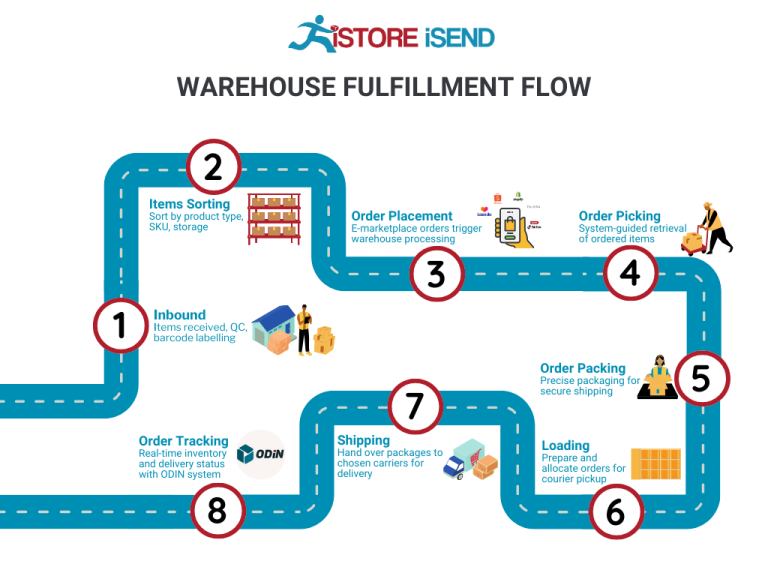
During order picking, pick lists are generated, which serve as guides for warehouse staff to locate and collect the necessary items. These lists can be printed or accessed via handheld devices, depending on the technology employed by the fulfillment center. Utilizing a systematic picking method, such as zone picking or wave picking, can further enhance efficiency. Streamlining this process not only speeds up order fulfillment but also helps in maintaining a high order accuracy rate, which is essential for customer retention.
4. Order Packing
After items have been picked, they move on to the packing stage. This step involves carefully packing the selected products into appropriate shipping containers while considering both protection and presentation. Proper packing ensures that products arrive at the customer’s door in pristine condition, which is vital for maintaining brand integrity and customer satisfaction.
A crucial aspect of order packing is packaging materials. Businesses must choose materials that provide adequate protection without incurring excessive costs. Additionally, branded packaging can enhance the unboxing experience, reinforcing brand identity and encouraging repeat purchases. This stage also often includes generating packing slips and shipping labels, which are essential for tracking and ensuring that the correct items are shipped.
5. Shipping & Delivery
The final step in the order fulfillment process is shipping and delivery. This involves handing off the packed orders to a carrier for transportation to the customer. Efficient shipping is key to meeting customer expectations, especially in today’s market, where fast delivery is often a decisive factor in purchasing decisions.
In this phase, businesses utilize shipping carriers such as USPS, UPS, or FedEx. The choice of carrier can affect shipping costs and delivery times, making it important for businesses to evaluate their options regularly. Additionally, providing customers with tracking information enhances their experience, allowing them to monitor their order’s progress. By ensuring timely and reliable delivery, businesses can significantly improve customer satisfaction and loyalty, which are critical for long-term success.
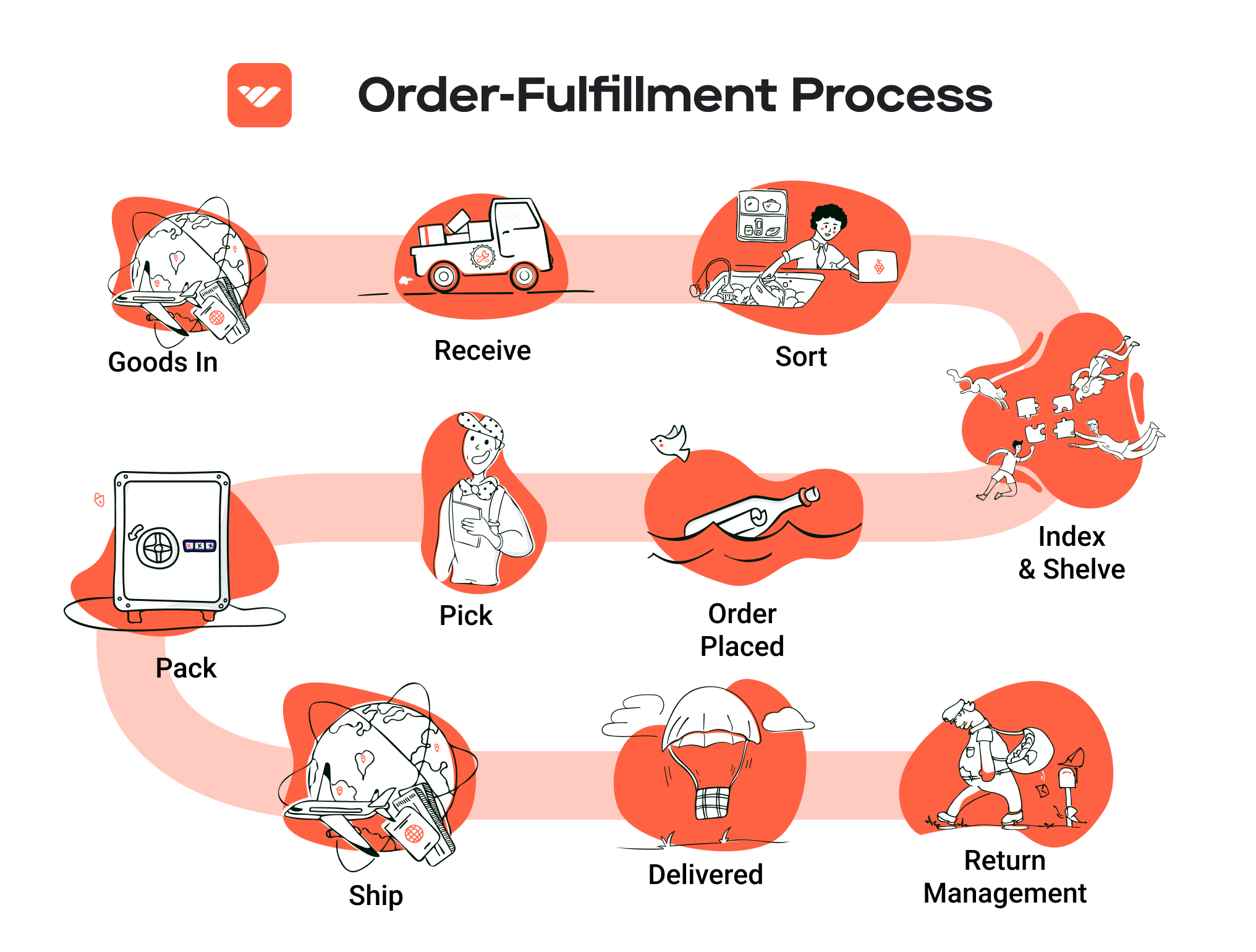
By understanding and optimizing each step of the order fulfillment process, e-commerce businesses can streamline operations, reduce costs, and ultimately enhance the customer experience. A well-executed fulfillment strategy not only supports business growth but also establishes a solid foundation for scaling logistics as demand increases.
Comparing Fulfillment Models: In-House vs. 3PL vs. Dropshipping
Fulfillment Model Comparison Table
| Model | Who Handles Inventory | Best For (Business Stage) | Key Advantage | Key Disadvantage |
|---|---|---|---|---|
| In-House Fulfillment | The business itself | Startups to established businesses | Complete control over inventory and processes | High overhead costs and resource demands |
| Third-Party Logistics (3PL) | A third-party service provider | Rapidly scaling businesses | Scalability and reduced operational burden | Less control over fulfillment processes |
| Dropshipping | Supplier/vendor | New entrepreneurs and small businesses | Low startup costs and minimal risk | Lower profit margins and potential delays |
In-House Fulfillment
In-house fulfillment involves managing the entire order fulfillment process internally. This model is often adopted by startups or established businesses that want to maintain complete control over their inventory, shipping, and logistics. By handling fulfillment in-house, businesses can customize their packing processes, branding, and customer interactions, creating a tailored experience for their customers. However, this model comes with significant overhead costs, including warehousing, staffing, and technology investments. Additionally, as order volumes increase, the operational demands can become overwhelming, leading to inefficiencies and potential errors. Therefore, while in-house fulfillment offers control and direct oversight, it may not be sustainable for businesses looking to scale rapidly without substantial investment in resources and infrastructure.
Third-Party Logistics (3PL)
Third-party logistics (3PL) services have gained popularity as businesses look for ways to streamline their fulfillment processes. In this model, a specialized logistics provider takes over the warehousing, inventory management, and shipping responsibilities on behalf of the e-commerce business. 3PL providers are particularly advantageous for companies experiencing rapid growth, as they offer scalable solutions that can adapt to fluctuating order volumes. They often have established relationships with carriers, enabling them to negotiate better shipping rates and delivery times. However, the trade-off is that businesses relinquish some control over their fulfillment processes. This can lead to challenges in communication and potential discrepancies in service levels if the 3PL does not align with the business’s operational standards. For many businesses, the benefits of reduced operational burdens and enhanced scalability outweigh the drawbacks, making 3PL a compelling option for those looking to grow.
Dropshipping
Dropshipping represents a unique fulfillment model where the e-commerce retailer does not hold inventory. Instead, when a customer places an order, the retailer purchases the item from a third-party supplier who then ships it directly to the customer. This model is particularly attractive to new entrepreneurs and small businesses because it requires minimal upfront investment and eliminates the need for warehousing and inventory management. Since there are no inventory costs, businesses can experiment with a broader range of products without the financial risk associated with unsold stock. However, dropshipping comes with its own set of challenges, such as lower profit margins and potential delays in shipping, as the retailer relies on suppliers to fulfill orders. Moreover, quality control can be an issue, as the retailer has limited oversight of the product before it reaches the customer. For those willing to navigate these challenges, dropshipping can be a low-risk entry point into e-commerce.
Conclusion
Choosing the right fulfillment model is crucial for e-commerce businesses looking to scale. Each model—In-House, 3PL, and Dropshipping—offers distinct advantages and disadvantages. In-house fulfillment provides control but at a higher cost and resource commitment. 3PL allows for scalability and operational efficiency, making it suitable for growing businesses, while dropshipping offers a low-risk entry point for new entrepreneurs, albeit with challenges related to profit margins and fulfillment speed. Understanding these dynamics will help business owners make informed decisions that align with their operational goals and growth strategies.
A Deep Dive into Amazon FBA: Pros, Cons, and Who It’s For
Understanding Fulfillment by Amazon (FBA)
Fulfillment by Amazon (FBA) is a service offered by Amazon that allows e-commerce sellers to store their products in Amazon’s fulfillment centers. Amazon then takes care of storage, packaging, shipping, and customer service for these products. This means that when a customer orders an item, Amazon handles the entire order fulfillment process, ensuring that products reach consumers swiftly and efficiently.
How FBA Works
-
Inventory Storage: Sellers send their products to Amazon’s warehouses, where they are stored until sold. Amazon provides guidance on preparing and labeling items to ensure they are ready for sale.
-
Order Processing: When a customer places an order for a product listed as fulfilled by Amazon, the order is automatically processed by Amazon’s systems. This includes picking the item from the warehouse, packing it, and shipping it to the customer.
-
Customer Service and Returns: Amazon manages customer inquiries and handles returns. This includes processing refunds and ensuring that returned items are restocked appropriately.
-
Multi-Channel Fulfillment: Sellers can also use FBA to fulfill orders from other sales channels, such as their own websites or other marketplaces, broadening their reach and simplifying logistics.
Pros of Fulfillment by Amazon
-
Prime Eligibility: One of the most significant advantages of using FBA is that products become eligible for Amazon Prime. This means they can be offered with fast, free shipping, which is a major incentive for many customers. Prime members are more likely to purchase items that are eligible for Prime shipping, which can lead to increased sales.
-
Customer Trust: Amazon is a well-established and trusted brand. By utilizing FBA, sellers can benefit from this trust. Customers often feel more secure purchasing from a seller who uses Amazon’s fulfillment services, as they associate Amazon with reliable service and quality.
-
Multi-Channel Fulfillment: FBA allows sellers to fulfill orders from various platforms, not just Amazon. This multi-channel fulfillment capability enables businesses to streamline their operations and manage inventory more efficiently across different sales channels.
-
Scalability: FBA allows businesses to scale their operations without the need to invest in warehousing and logistics infrastructure. Sellers can focus on growing their brand and increasing product offerings while Amazon handles the complexities of order fulfillment.
-
Time Savings: By outsourcing fulfillment to Amazon, sellers can save significant time and resources. They can concentrate on marketing, product development, and customer engagement instead of the logistics of order processing.
Cons of Fulfillment by Amazon
-
High Fees: One of the most notable downsides of FBA is the cost. Amazon charges various fees for storage, fulfillment, and other services. These fees can add up quickly, especially for sellers with lower margins, making it crucial to analyze whether FBA is financially viable for their business.
-
Strict Inventory Rules: Amazon has stringent rules regarding inventory management. Sellers must adhere to guidelines about inventory limits, storage fees, and performance metrics. Failing to comply can lead to penalties or even account suspension, putting businesses at risk.
-
Commingling Risks: With FBA, products from different sellers may be stored together in the same fulfillment center, which is known as commingling. This can pose risks for sellers, particularly if a customer receives a product that is not theirs or if there are quality issues with another seller’s inventory. Additionally, if there are issues with inventory tracking, it can lead to complications in managing returns and customer satisfaction.
-
Loss of Brand Control: When using FBA, sellers may have less control over the packaging and presentation of their products. While Amazon does offer branded packaging options, the level of customization is limited compared to fulfillment options where sellers manage their logistics.
-
Dependence on Amazon’s Policies: Sellers become dependent on Amazon’s policies and procedures. Any changes made by Amazon regarding fees, fulfillment processes, or policies can directly impact sellers’ operations and profitability.
Who is FBA Best For?
Fulfillment by Amazon is best suited for certain types of sellers:
-
High-Volume Sellers: Those who sell a high volume of products can benefit significantly from FBA’s efficiency and scalability, offsetting the high fees with increased sales.
-
Brands Seeking Visibility: Sellers looking to enhance their brand’s visibility on Amazon and reach Prime members will find FBA advantageous.
-
E-commerce Entrepreneurs: Startups and small businesses that want to focus on growth without managing logistics themselves can leverage FBA to streamline operations.
-
Multi-Channel Sellers: Businesses that sell on multiple platforms and need a reliable fulfillment partner will benefit from FBA’s multi-channel fulfillment capabilities.
-
Products with Fast Turnover: Items that sell quickly and have a high demand can offset the storage fees associated with FBA, making it a cost-effective solution.
In summary, while Fulfillment by Amazon offers numerous advantages that can significantly benefit e-commerce businesses, it is essential to weigh these against the potential downsides. Understanding the operational and financial implications of FBA will enable sellers to make an informed decision about whether this fulfillment method aligns with their business goals and strategies.
Core Services Offered by Fulfillment Centers
Inventory Management & Warehousing
Effective inventory management and warehousing are foundational services offered by fulfillment centers, enabling e-commerce businesses to optimize their stock levels and storage solutions. Fulfillment centers provide secure storage space for products, ensuring that inventory is safely housed until it’s ready to be shipped.
One of the primary benefits of this service is the ability to streamline operations. With a centralized location for inventory, businesses can minimize the complexity and cost associated with managing multiple storage sites. Fulfillment centers utilize advanced inventory management systems that provide real-time visibility into stock levels, allowing businesses to monitor their inventory efficiently. This capability helps prevent stockouts and overstock situations, which can lead to lost sales or increased holding costs.
Additionally, many fulfillment centers offer no long-term storage fees, making it financially viable for businesses to store a variety of products without incurring hefty expenses. This flexibility is particularly advantageous for seasonal products or new product launches, where demand can be unpredictable.
Pick and Pack Services
Pick and pack services are critical for ensuring that orders are processed accurately and efficiently. This process involves the selection (picking) of products from inventory and packaging (packing) them for shipment. Fulfillment centers employ trained staff and utilize optimized workflows to enhance the speed and accuracy of order fulfillment.
The primary benefit of pick and pack services lies in their ability to improve order accuracy and reduce lead times. A well-executed pick and pack operation can significantly decrease the time from order placement to delivery, enhancing customer satisfaction. This is crucial in today’s e-commerce landscape, where consumers expect fast and reliable shipping.
Moreover, fulfillment centers often use sophisticated technology, such as barcode scanning and inventory management software, to ensure that the correct items are picked and packaged. This minimizes errors and enhances operational efficiency, ultimately leading to better customer experiences and lower return rates.
Kitting and Assembly
Kitting and assembly services are specialized offerings that allow e-commerce businesses to combine multiple products into a single package or kit before shipping. This process can include assembling products, packaging them together, and sometimes even branding the kits with custom labels or packaging.
The benefit of kitting and assembly lies in its ability to create unique product offerings that can enhance customer appeal. For example, subscription box services frequently rely on kitting to provide curated experiences for their customers. By offering products in a bundled format, businesses can increase perceived value and drive sales.
Additionally, kitting can streamline inventory management by reducing the number of SKUs (Stock Keeping Units) that need to be tracked individually. This simplification can lead to improved inventory accuracy and easier management, freeing up resources for other business activities.
Returns Management (Reverse Logistics)
Returns management, or reverse logistics, is an essential service that addresses the inevitable reality of e-commerce: returns. Fulfillment centers typically handle the entire returns process, from receiving returned items to inspecting and restocking them.
The primary benefit of efficient returns management is that it can turn a potentially negative experience into a positive one for customers. A well-structured returns process increases customer trust and satisfaction, encouraging repeat business. Many consumers base their purchasing decisions on the ease of returns; therefore, a fulfillment center that manages returns effectively can provide a competitive advantage.
Moreover, fulfillment centers often utilize technology to track returns and update inventory levels in real-time. This ensures that businesses have an accurate picture of their stock and can quickly restock items that are returned in sellable condition. Additionally, effective returns management can help identify patterns in returns, enabling businesses to address quality issues or adjust their product offerings based on customer feedback.
Conclusion
In the rapidly evolving e-commerce landscape, partnering with a proficient fulfillment center can significantly enhance operational efficiency and customer satisfaction. By leveraging core services such as inventory management and warehousing, pick and pack services, kitting and assembly, and returns management, e-commerce businesses can scale their operations effectively. These services not only streamline logistics but also create a seamless experience for customers, ultimately driving growth and profitability. As you consider fulfillment options, prioritize providers that offer comprehensive, technology-driven solutions tailored to your specific needs.
How to Choose a Fulfillment Partner: A 6-Point Checklist
Location & Warehouse Network
Importance:
The geographical location of a fulfillment partner’s warehouses can significantly impact shipping times and costs. A partner with strategically located warehouses can help you reach your customers more efficiently, reducing shipping times and costs.
Questions to Ask:
– Where are your warehouses located, and how do they align with our target markets?
– Do you have the capability to expand your warehouse network if our sales grow in new regions?
– What are your shipping times from each warehouse to key customer locations?
Technology & Integrations
Importance:
In today’s digital age, robust technology and seamless integrations with your existing e-commerce platforms are crucial for streamlined operations. A partner that offers advanced technology can improve order accuracy, inventory management, and overall efficiency.
Questions to Ask:
– What order fulfillment technology do you use, and how does it integrate with popular e-commerce platforms?
– Can your system provide real-time inventory tracking and reporting?
– How do you handle updates and maintenance of your technology to ensure reliability?
Specializations (e.g., Cold Storage, Oversized Items)
Importance:
Depending on your product range, you may require a partner with specific capabilities, such as cold storage for perishable goods or specialized handling for oversized items. Ensuring your partner can meet these needs is essential for maintaining product integrity and customer satisfaction.
Questions to Ask:
– What specializations do you offer, and how do they align with our product needs?
– Can you handle products that require special storage conditions or handling procedures?
– What experience do you have with businesses in our industry or product category?
Scalability & Capacity
Importance:
As your business grows, your fulfillment needs will evolve. A partner that can scale with you—whether through additional warehouse space, enhanced technology, or increased staffing—will be crucial for maintaining service levels during peak seasons or rapid growth phases.
Questions to Ask:
– How do you manage fluctuations in order volume, such as during seasonal peaks?
– What is your current capacity, and how quickly can you scale operations if needed?
– Have you supported other clients through rapid growth, and can you share those experiences?
Pricing and Contracts
Importance:
Understanding the cost structure and terms of service is vital for budgeting and financial planning. Transparent pricing and flexible contract terms can help you avoid unexpected costs and ensure a mutually beneficial partnership.
Questions to Ask:
– Can you provide a detailed breakdown of your pricing structure, including any hidden fees?
– What are your contract terms? Are there long-term commitments or minimum order requirements?
– How do you handle pricing during peak seasons or for bulk orders?
Customer Support & Reviews
Importance:
Exceptional customer support can make a significant difference in your fulfillment experience. A partner with responsive, knowledgeable support can help resolve issues quickly, minimizing disruptions to your operations. Additionally, reviews and testimonials can provide insight into the partner’s reliability and quality of service.
Questions to Ask:
– What type of customer support do you offer (e.g., dedicated account manager, 24/7 support)?
– Can you provide references or case studies from clients in our industry?
– How do you handle customer complaints or issues during the fulfillment process?
Conclusion
Choosing the right fulfillment partner is a critical decision that can influence your business’s success. By using this checklist, you can systematically evaluate potential partners based on their location, technology, specializations, scalability, pricing, and customer support. Taking the time to ask the right questions will help ensure you find a fulfillment partner that aligns with your business goals and growth trajectory. As you assess each potential partner, remember that a strong partnership is built on transparency, communication, and shared objectives.
Understanding Fulfillment Pricing: A Breakdown of Common Fees
Initial Setup Fees
Initial setup fees are one-time charges that cover the costs associated with onboarding your business to a fulfillment service. This can include setting up your account, integrating your e-commerce platform, and configuring inventory management systems. Depending on the provider, these fees can vary significantly. Some fulfillment centers may waive initial setup fees to attract new clients, while others might charge a flat fee or a percentage based on your expected order volume.
To calculate initial setup fees, providers typically assess the complexity of your operations. For instance, if you require custom software integrations or extensive training for your team, expect higher fees. Conversely, businesses with straightforward needs may find providers willing to offer free setup as part of a promotional strategy.
Receiving Fees
Receiving fees are charged when your inventory arrives at the fulfillment center. This fee covers the labor and resources required to unload, inspect, and stock your products in the warehouse. Typically calculated on a per-unit basis, receiving fees can also be influenced by the complexity of the items being received. For example, if your products require special handling or labeling, the receiving fees may increase.
To estimate your receiving fees, consider the volume of inventory you plan to send and the average size of your products. Many fulfillment services have tiered pricing structures, where the cost per unit decreases as the volume increases. Always inquire about potential discounts for larger shipments.
Storage Fees (per pallet/bin)
Storage fees refer to the charges for keeping your inventory in the fulfillment center. These fees are usually calculated on a per pallet or per bin basis, depending on how the provider organizes their warehouse space. Storage fees can vary widely depending on the location of the fulfillment center, the size of your products, and the duration for which the products will be stored.
Most fulfillment centers charge monthly storage fees, which can be based on the total volume of space your products occupy. Some providers may also implement long-term storage fees for items that remain in the warehouse for an extended period, typically over six months. To manage storage costs, regularly assess your inventory levels and consider employing a just-in-time inventory strategy to minimize the duration of storage.
Pick & Pack Fees (per item/order)
Pick and pack fees are charged for the labor involved in retrieving items from storage and preparing them for shipment. This fee is typically calculated on a per-item or per-order basis, depending on how the fulfillment center structures its pricing. For instance, if you sell a product that requires multiple items to be picked for a single order, you may incur higher pick and pack fees.
These fees can vary based on several factors, including the complexity of the packing process (e.g., custom packaging or kitting) and the efficiency of the fulfillment center. Some providers may also offer bulk discounts for businesses with high order volumes. To optimize your costs, consider streamlining your product offerings or choosing a fulfillment service that specializes in your product category.
Shipping Fees
Shipping fees are among the most variable costs in the fulfillment pricing structure. These fees cover the cost of transporting your products from the fulfillment center to your customers. Shipping fees can be affected by several factors, including package weight, dimensions, shipping speed, and destination.
Most fulfillment centers partner with multiple shipping carriers, allowing them to offer competitive rates. Shipping fees can either be charged directly to you or passed on to your customers at checkout. To calculate shipping costs, consider utilizing the fulfillment center’s shipping software, which can provide estimates based on real-time data from various carriers. Additionally, inquire about any available discounts for bulk shipments or long-term contracts with specific carriers.
Tips for Getting an Accurate Quote
-
Detail Your Requirements: When requesting a quote, provide detailed information about your product types, expected order volumes, and any special handling needs. This will help the provider give you a more accurate estimate.
-
Compare Multiple Providers: Don’t settle for the first quote you receive. Obtain estimates from several fulfillment centers to compare pricing structures, service offerings, and terms.
-
Ask About Hidden Fees: Ensure you understand all potential charges, including those for returns, additional packing materials, or special services. Request a comprehensive list of fees to avoid surprises later.
-
Negotiate Terms: Many fulfillment providers are open to negotiating fees, especially if you can commit to a long-term partnership or high order volumes.
-
Review Contracts Carefully: Before signing any agreements, review the terms and conditions thoroughly. Pay special attention to clauses related to fees, minimum commitments, and cancellation policies.
By understanding the various fulfillment pricing models and how they are calculated, you can make informed decisions that align with your business goals and budget, ultimately setting your e-commerce business up for scalable success.
Frequently Asked Questions (FAQs) about Fulfillment
1. What is order fulfillment in eCommerce?
Order fulfillment in eCommerce refers to the complete process of receiving, processing, and delivering customer orders. This includes inventory management, picking and packing items, shipping, and handling returns. Efficient order fulfillment is crucial for customer satisfaction and operational efficiency.
2. What is a fulfillment center?
A fulfillment center is a specialized warehouse designed to handle the storage, packing, and shipping of products for eCommerce businesses. Unlike traditional warehouses, fulfillment centers are equipped with technology and processes tailored for quick order processing and efficient logistics, making them integral to the eCommerce supply chain.
3. What’s the difference between a warehouse and a fulfillment center?
While both warehouses and fulfillment centers store products, their functions differ significantly. A warehouse primarily focuses on long-term storage and inventory management, whereas a fulfillment center emphasizes speed and efficiency in processing orders, ensuring timely delivery to customers. Fulfillment centers also offer services like pick and pack, kitting, and returns processing.
4. What is a 3PL (Third-Party Logistics)?
A 3PL, or third-party logistics provider, is a company that offers logistics services to eCommerce businesses. This includes warehousing, inventory management, order fulfillment, and shipping. Utilizing a 3PL allows businesses to outsource their logistics operations, enabling them to focus on growth and customer engagement without the complexities of managing logistics in-house.
5. How much do fulfillment services cost?
The cost of fulfillment services varies based on several factors, including order volume, storage space, shipping methods, and additional services (like kitting or returns processing). Many fulfillment providers offer tiered pricing models or pay-as-you-go options, allowing businesses to find a solution that fits their budget and scaling needs.
6. How do I choose the right fulfillment service provider?
To choose the right fulfillment service provider, consider factors such as:
– Service offerings: Ensure they meet your specific needs (e.g., international shipping, returns management).
– Technology integration: Check if they can seamlessly integrate with your eCommerce platform.
– Location: Proximity to your customer base can impact shipping times and costs.
– Customer support: Reliable support is crucial for resolving issues quickly.
– Reputation: Look for reviews and case studies to gauge their reliability and effectiveness.
7. What is the typical order processing time for fulfillment services?
Order processing times can vary by provider and the complexity of the order but typically range from 1 to 3 business days. Factors influencing processing times include the provider’s operational efficiency, the volume of orders, and the specific services required (like kitting or customization).
8. Can I manage my inventory in real-time with fulfillment services?
Yes, many fulfillment service providers offer real-time inventory management systems that allow you to track stock levels, order statuses, and shipment progress. This technology can integrate with your eCommerce platform, providing you with up-to-date information anytime, anywhere.
9. How do fulfillment services handle returns?
Fulfillment services typically include a returns management process that handles the receipt, inspection, and restocking of returned items. This ensures your inventory levels remain accurate and allows for efficient processing of customer returns, improving overall customer satisfaction.
10. What are the benefits of using a fulfillment service for my eCommerce business?
Utilizing a fulfillment service offers numerous benefits, including:
– Cost savings: Reduces overhead costs associated with warehousing and staffing.
– Scalability: Easily adapt to fluctuating order volumes without the need for significant investment.
– Expertise: Gain access to logistics professionals with industry knowledge.
– Focus on core business: Allows you to concentrate on marketing, product development, and customer engagement while leaving logistics to the experts.
– Improved customer experience: Faster processing and shipping lead to higher customer satisfaction and repeat business.
Conclusion: Is Outsourcing Fulfillment the Right Move for Your Business?
Evaluating the Benefits of Outsourcing Fulfillment
Outsourcing your e-commerce order fulfillment can be a strategic move that unlocks significant advantages for your business. By partnering with a reliable fulfillment service, you can save precious time, allowing you to focus on core business activities such as product development, marketing, and customer engagement. This increased focus can lead to enhanced innovation and ultimately, greater sales growth.
Scalability is another key benefit of utilizing a fulfillment service. As your business grows, your logistics needs will evolve. A fulfillment partner can easily adapt to your changing requirements, whether you’re experiencing seasonal spikes in demand or expanding your product lines. This flexibility ensures that you can scale operations without the hassle of managing complex logistics in-house.
Moreover, leveraging the expertise of a fulfillment service can elevate your operational efficiency. Experienced fulfillment providers bring industry knowledge, advanced technology, and established shipping networks that can enhance your order accuracy and reduce shipping costs. This expertise can significantly improve your customer satisfaction rates, which is critical in today’s competitive e-commerce landscape.
However, the success of this strategy hinges on selecting the right fulfillment partner. It’s essential to evaluate potential providers based on their capabilities, customer service, and alignment with your business goals. The right partner will not only handle your logistics but will also become a vital extension of your brand.
Take Action Today
To determine if outsourcing fulfillment is the next logical step for your business, conduct a thorough audit of your current shipping process. Assess your operational efficiencies, costs, and customer feedback. This evaluation will provide clarity on whether a fulfillment partner can help streamline your logistics and foster your growth. Don’t wait—start exploring your options today and position your business for success!
Important Disclaimer
⚠️ Important Disclaimer
The information in this guide is for educational purposes. Fulfillment services, pricing, and platform features change frequently. Always conduct your own due diligence and consult with providers directly before making business decisions.
